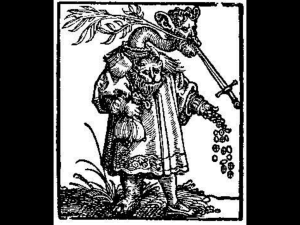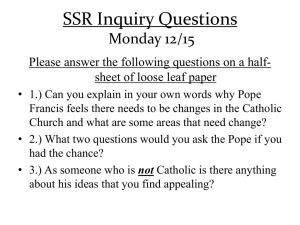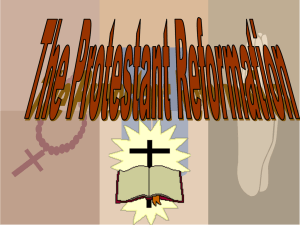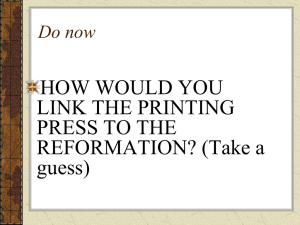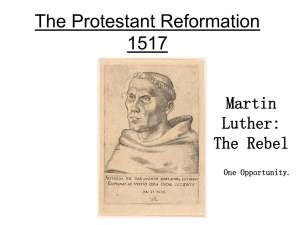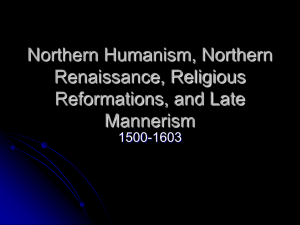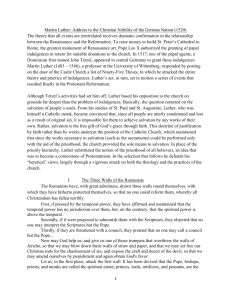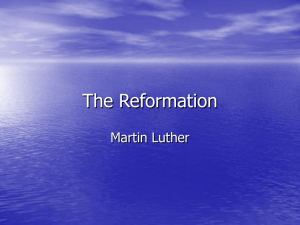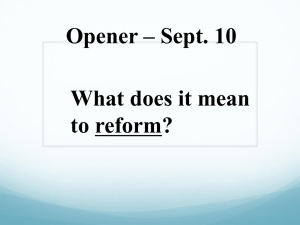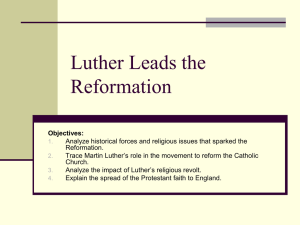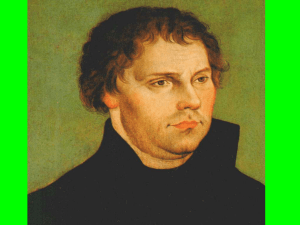Western Civilization II Reformation to Post Modernism
advertisement
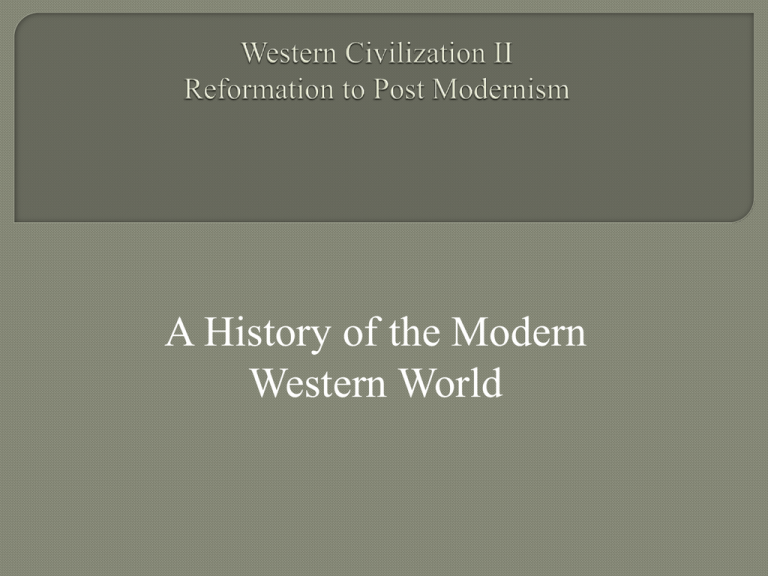
A History of the Modern Western World We as Americans are shaped culturally and politically and socially by our Western European Heritage. History has recorded Europe as transforming from a Hunter-Gatherer to an agrarian society to an industrial Nation-State; Then it moved into a monarchy, superstitious, Enlightenment, medieval technological and democratic liberal government—forces of Capitalism and Communism—and postModern nuclear world—stable or unstable is the big question. Importance of the West! It is far more than a “Dead White Male” History. It is a crucible to modernity; A road map that tells us where we came from and what obstacles we have over come and what obstacles we have constructed. It is our Journey—there are many other societies and cultures of equal billing, but arguably Western Civilization has a major and profound effect on global modern society. With all its faults, Western Civilization ended Slavery, set patriarchy on the way to destruction, and promoted and ensured Gender Rights. It is true that many western cultures trace their lineage to Eastern cultures, but western culture had a deeper influence than their Eastern heritage—not in all cases, but most. Not superior, just more immediate. We study it because it permeates our culture, poetry, politics, traditions, and economic structure. Pillars of western thought: a) “All men/women are created equal.” b) “No taxation w/o representation.” c) “People united cannot be defeated.” d) A Free Press e) Limited Government f) Innocent until proven guilty g) Jury of our Peers Far from celebrating dead white men, it is a system of tools and ideas and human dignity that allow humans to achieve justice and freedom—w/o western civ, we have totalitarian and murderous regimes. Still, a caveat, the west has spent a great deal of money, technology, and lives killing each other for sundry reasons, mostly economic … Just look around the world at the unrest of the western and eastern worlds—both are in disarray. Underlying Philosophy—very simple; European History is more than Kings, Queens, and Princes or even ‘Watershed’ events—it is common ordinary people—who worried about love, life and death. There were large cultures on the borders of Europe that influenced Europe and its World View. Reality—It is about when we stopped being Medieval and became modern and our place in the Great Chain of Being. As Italian Historian DeBennedetti once suggested, “I bring my own prejudices, biases, interpretations and personal idealistic attitudes with me. I do not apologize for they make me who I am and allow history to have character and form.” That is exactly why Socialism and Communism, and Totalitarianism has never worked. We are too individual and independent and self-important—if everyone were the same it would be a dull world—if that axiom is true as DeBennedetti suggested then why do we seek such an arrangement? For our course Western Civ II and to fulfill the maturation of the individual into a Nation-State model of liberty and justice— Reformation –catalyzed by Martin Luther. However, the reality is Luther got away with the Reformation because so many people in the world did not realize it was happening—their churches, lives, and communities remained basically unchanged. Still, it is a beginning. What were the great turning points? What made us a modern political and socially liberal society? 6 Big events: 1) Renaissance (Humanism) 2) Centralized Nation-States 3) Discovery of America 4) Printing Press; knowledge dissemination 5) Protestant Reformation 6) Rational and Scientific Revolutions We begin with Reformation. Martin Luther and the Reformation The Reformation- in historical context—is an historical phenomenon. Big watershed event in Western Civilization; along with Classical antiquity, Jesus Christ, Mohammad, English Common Law and the Constitution of the United States. May seem relatively unimportant today, but without the Reformation “justification by faith” and ‘Grace’ would be tied to iconography, politics, and human intervention. Christianity declared official religion of Roman Empire in 391 AD. 1054 AD Christianity split into two camps; Western Europe ROME; the Bishop of Rome, the Pope or the ‘Vicar of Christ.’ Eastern Europe (Russian and Ottoman Christians; an eastern orthodox of patriarchy based on the model of Constantinople under the Greek Orthodox tenet. (never the power of the Roman Pope (Greek and Russian orthodoxies split-1448) Europeans established Christianity as the official religion. 1) Investiture—Rulers and officials were crowned or Vested by the Church; 2) Bishops, until very recently, were advisors to rulers and heads of state; 3) Church taxed a high proportion of people’s and state’s income; 4) The State as corollary to Church power and influence, made attending mass and the persecution of heresy mandatory. Jews, Muslims, and other minority groups including women were relegated to second class status; 1295 AD church ruled all Jews must wear a badge or marker of identification; They could not employ Christians, or work for Christians and could not show their face at Christmas or Easter; Jews, to the bane of Christians and Muslims, however found a niche in banking because of their ambivalence to Usury. Jews were expelled from England in 1290 AD; France in 1306 AD; and again in 1394 AD; Germany it varied from time to time and intensity. Medieval Spain tolerated the Jews and Muslims, but by the time of the Columbian Exchange, the Jews and Muslims were expelled from Spain. The exception was Poland—welcomed the Jews—got them in trouble during the Nazi regime of the 20th century. Issues arising on the horizon: Kings wanted to rid themselves of the Churches influence and claim to higher power; Wanted sole jurisdiction of their kingdoms; Resented Papal power to tax them and their subjects, or be exempt from the state tax; Kings wanted to appoint Bishops because of their position as advisors and royal vassals. Secularization and the Great Schism of the Church weakened the authority of the Church—open door for the Reformation; The church refused or neglected the moral example and many people became very disillusioned w/ Church; Popes behaved as Machievellian Princes rather than men of God—still the Church flourished. Still, cracks in Christendom. Monies and Taxes were being sent to Far away Rome—Church seemed more worldly than spiritual—indulgences though an accepted practice began to weigh heavily on the more moral conscience of society. Remember the Algensians, Lollards, and Hussites wanted a less worldly church, less authoritarian , a vernacular translation of scriptures, stronger laity influence—again cracks are showing. Before, Luther it was understood and accepted that all authority was vested in a temporal and spiritual head—vested by God, this meant the Holy Roman Emperor and the Pope; The Epistola Clementis juxtaposed with scriptural text from Matthew and Peter conferred absolute authority in these entities and held sway over Church and Earth—stamped by Heaven; Power was Monarchical and derived from God without human mediation or council. Role Preserve Prevent of the Church apostolic teachings intrusion of error (only the church could explain scriptures) Eradicate heresy Safe guard the Creeds (Nicene…) Enshrined Monasticism and asceticism Teach life according to scriptures Administer discipline, wherever needed Luther’s path to reform—two branches: 1) influenced by Christian Humanism; shared the humanist dislike for Scholasticism; accepted much of the criticism of the Church of the period. 2) Highly sensitive personality; prone to deep thoughts, doubts, and at times extreme pessimism; considered himself and all others unworthy of God; It was truly God’s grace that allowed salvation. Indulgences, by the time of Luther, was a fairly common practice; If a church could have a greater relic than others, it had more favor with God. Luther disagreed on two counts—it was only a material example of ‘Good works’ which was not efficacious alone; It transferred too much money and power to the Viennese bankers and the Pope, or Rome. The 95 Theses were a disputation (academic debate) against indulgences; in reality this was not uncommon for academics wishing to debate or clarify questionable issues of human and spiritual concern—would later be a gesture of defiance. Many of the humanists greeted the Theses warmly—the Church first tried to discipline him at Wittenberg; Luther could be incorrigible—especially when he was certain of his correctness. 1. Some things the Church could agree needed redressing and correcting, but true to Luther’s temperament, he went further: The pope has neither the will nor the power to remit any penalties beyond those imposed either at his own discretion or by canon law. 2. The pope himself cannot remit guilt, but only declare and confirm that it has been remitted by God; 1. The penitential canons apply only to alive people, and according to the canons themselves, none applies to the dead. 2. Now, direct defiance of the Pope and fundamental tenets of the Church; 3. Luther rejected the authority of the Popes and Lateran Councils—direct course of separation from Rome; 4. Not his original intention, but there it is. Luther’s 3 fundamental tenets: 1) Print Bible in the Vernacular for public consumption; 2) Printed bibles means no need for a sacrosanct clergy ie, priests, bishops, even Popes to interpret for the public; 3) A religious dogma or practice w/o scriptural foundation much be rejected, along with iconography, rituals, and hierarchy—Luther sought secular authority. Luther published three (3) great treatises: 1) Address to the German Nobility to reform the church, you must desist all payments and tributes to Rome; ban clerical celibacy, end masses for the dead, and ignore desires for pilgrimages—these were all works without faith; 2) Babylonian Captivity of the Church— end all these useless practices, offer communion to the laity—and only Baptism and Communion were valid sacraments. Transubstantiation was real. 3) On the Freedom of a Christian Man— salvation depended solely on faith and grace—therefore all men were free of ‘Good works’ as the only road to salvation. 1520 Rome condemned 41 of Luther’s 95 points; 1521 At Pope Leo X excommunicated Luther the Diet of Worms in 1521, Luther refused to recant—he was granted safe conduct to Saxony—Frederick the Elector III protected him. He laid down the doctrine of what would become Protestantism—They who Protest; Core of his teachings rest in three “alones” or “onlys.” Sola Fide—Salvation is “by faith alone.” Faith is free and is a gift from God. (Erasmus—an exercise of free will, people could choose to believe); Sola Gratia—salvation depends on the grace of God alone—his gift is independent of human action—it is because of Christ’s death on the Cross— man need only have faith, believe, accept, and ask … Sola Scriptura—the “Bible alone” teaches all we need to know and is the single source of authority—Popes, councils, and traditions were sinful man-made inventions to keep people loyal to a human endeavor—not to God as it should be … Luther was prophetic, with all his defects and weaknesses and his seeming over virtuous character of himself; He initiated profound and penetrating judgment immersed in biblical scholarship with an impressive intellectual mind; The most prominent spiritual leader of his time; Set the tone for individual freedom of thought.
